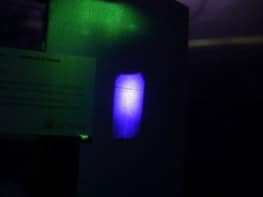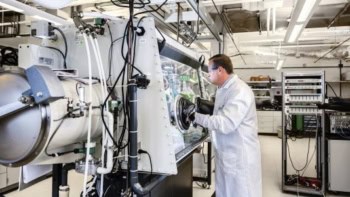Scientists in Japan have made the first device that can convert solar energy into electricity and then store the resulting electric charge. The "photocapacitor" designed by Tsutomu Miyasaka and Takurou Murakami at Toin University in Yokohama could be used to power mobile phones and other hand-held devices (Appl. Phys. Lett. 85 3932).

Conventional solar cells need a secondary device, such as a battery, to store the electrical power generated from light. The photocapacitor combines the photoelectric and storage functions in a single structure.
The Japanese device consists of two electrodes — a light-absorbing photoelectrode made of semiconducting titanium dioxide and a counterelectrode made of platinum coated glass — separated by a resin film. Both electrodes include a porous layer of activated carbon that has a large surface area. All three layers are filled with an ionic solution and form a capacitor that has a light collection area of 0.64 square centimetres (see figure).
Photons are collected by photoreceptor dye molecules on the surface of the titanium dioxide layer. When exposed to light, electrons from the dye molecules are transferred to the conducting band in the titanium dioxide layer, thus producing a current. They then transfer to the activated carbon layer at the counterelectrode via an external circuit.
Conversely, the positively charged holes left behind are transferred to the carbon layer at the photoelectrode. The accumulation of positive and negative charges at different carbon layers therefore allows the device to store energy or charge like a capacitor. The energy can be released by simply discharging the device.
“The photocapacitor is twice as efficient as traditional silicon-based solar cells in utilising weak light,” Miyasaka told PhysicsWeb. “This means that it can utilise indirect sunlight, for example on cloudy or rainy days, and even indoor light. Moreover, it can release electrical energy anytime, even in the dark.”
Miyasaka says that the next goal is to increase the charging voltage and the charge-discharge capacity to a practically and industrially useful level for applications.



